#automated label applicator
Explore tagged Tumblr posts
Text
Automated Label Applicators: Streamline Your Labelling Process
Automated label applicators are designed to increase efficiency by automating the label application process. Explore various options to suit your industry and product specifications. Inquire now for details!
0 notes
Text

When choosing the best automatic label printer and applicator for your business, several factors must be considered to ensure efficiency, quality, and cost-effectiveness.
Product & Labels information
Application information – Label location and photo
Transmission device and photo
Signal/Sensor
Maintenance and Support
Cost and Return on Investment (ROI)
#Label Printer and Applicator#Integrated Labeling Machine#Automated Labeling System#Labeling Equipment
0 notes
Text
Inline Label Applicators: Streamlining Your Labeling Process for Maximum Productivity
In today’s highly competitive manufacturing and packaging industries, efficient labeling plays a crucial role in maintaining product quality, brand image, and regulatory compliance. The labeling process, though often considered a small step in production, directly impacts a business’s overall operational efficiency. As demand for higher productivity and streamlined operations grows, inline label…
0 notes
Text
The Importance of Cable Management in Electrical Panels

In modern electrical installations, particularly in industrial, commercial, and residential applications, cable management in electrical panels plays a critical role. Poor cable organization can lead to inefficiencies, overheating, safety hazards, and costly downtime. Implementing proper cable management is not just a technical necessity — it’s a long-term investment in the performance, safety, and scalability of your electrical system.
What is Cable Management in Electrical Panels?
Cable management refers to the planning, installation, and maintenance of cables within an electrical panel to ensure neatness, organization, and optimal functionality. It includes the use of accessories such as cable ties, ducts, cable trays, wire markers, and labeling systems.
Common Components Used:
· Cable trays and ducts
· Cable ties and clips
· Wire markers and labels
· Conduits and sleeves
· Cable management panels and grommets
Why is Cable Management Important in Electrical Panels?
1. Enhances Electrical Safety
Proper cable routing reduces the risk of:
· Short circuits
· Arc flashes
· Fire hazards due to overheating or overloading
· Accidental disconnections or loose terminals
Safety is non-negotiable in any electrical system, and disorganized wiring is a known contributor to accidents and failures.
2. Improves System Reliability and Performance
A clean layout ensures stable voltage and current flow by minimizing electrical interference (EMI/RFI). It helps in:
· Preventing signal loss
· Reducing cross-talk in data cables
· Maintaining consistency in power distribution
3. Simplifies Maintenance and Troubleshooting
With labeled and properly routed cables:
· Technicians can quickly identify circuits and connections
· Downtime during maintenance is significantly reduced
· Errors due to wrong connections are minimized
4. Optimizes Space and Panel Layout
Efficient cable arrangement allows:
· Better airflow and heat dissipation
· Accommodation of future upgrades or expansions
· Reduced clutter and stress on terminal blocks
5. Compliance with Standards
Organizations such as IEC, NEC, and IEEE provide guidelines on wiring practices. Adhering to these standards not only ensures safety but also legal compliance during audits and inspections.
Best Practices for Cable Management in Electrical Panels
✅ Plan Before You Install
· Design the cable layout during the panel design phase
· Use CAD software for accurate visualization
✅ Use Quality Cable Management Accessories
· Invest in fire-resistant and durable cable trays and ducts
· Use color-coded wire markers for quick identification
✅ Ensure Proper Bending Radius
· Prevent cable damage by maintaining manufacturer-recommended bend radii
✅ Label Everything Clearly
· Use laser-printed or pre-numbered labels for durability and readability
✅ Separate Power and Signal Cables
· Avoid EMI by isolating high-voltage and low-voltage cables
✅ Secure Cables Firmly
· Use cable ties, clamps, or holders to prevent movement or vibration
✅ Regularly Inspect and Maintain
· Schedule routine inspections to spot frayed, loose, or overloaded cables

Industries Where Cable Management is Critical
· Manufacturing Plants — High-voltage systems and automated machinery
· Data Centers — Dense cable infrastructure and sensitive equipment
· Commercial Buildings — Office automation, security systems
· Healthcare — Life-support systems and diagnostic machines
· Renewable Energy — Solar inverters, battery management panels
Conclusion
Cable management in electrical panels is more than just a matter of aesthetics — it’s a critical component of a safe, reliable, and future-proof electrical system. From enhanced safety to easier maintenance and compliance, the benefits far outweigh the costs. Whether you’re an installer, facility manager, or system designer, investing in organized and well-planned cable management is a smart, long-term decision.
#electrical#electrical equipment#electrical supplies#switchgear#911 abc#oman#arcane#artists on tumblr#batman#cats of tumblr
3 notes
·
View notes
Text
Best Practices for Safe and Efficient LV Electrical Installations in 2025

Introduction
Low Voltage (LV) electrical installations are the backbone of safe and reliable power distribution in residential, commercial, and industrial settings. In 2025, as energy demands rise and smart technologies evolve, following best practices in LV installations is more important than ever to ensure safety, efficiency, and compliance.
This blog outlines the latest best practices for designing, installing, and maintaining LV electrical systems according to international standards and industry trends.
What Is an LV Electrical Installation?
LV (Low Voltage) refers to electrical systems that operate at voltages up to 1000V AC or 1500V DC. These installations include:
· Electrical panels and switchboards
· Distribution circuits
· Lighting systems
· Sockets and fixed appliances
· Motor control systems
Proper LV installation ensures that power is distributed safely and efficiently without risk of fire, equipment failure, or personnel injury.
Why Best Practices Matter in 2025
In the age of smart buildings, renewable integration, and digital energy management, the quality of your LV installation affects:
· Operational reliability
· Energy efficiency
· System lifespan
· User safety
· Regulatory compliance
Failing to adhere to best practices can result in costly downtime, legal penalties, and even life-threatening hazards.
Top Best Practices for Safe and Efficient LV Electrical Installations
1. Conduct Detailed Load Analysis
Before starting any LV installation, carry out a comprehensive load assessment to determine the power requirements, load types, and future expansion needs. This ensures:
· Proper cable sizing
· Correct protection device selection
· Optimized system capacity
Use load flow software tools and factor in diversity and demand coefficients for accuracy.
2. Follow International Standards (IEC, NEC)
Compliance with recognized standards ensures installations meet safety and performance benchmarks. Key references include:
· IEC 60364 for LV electrical installations
· NEC (NFPA 70) for code-compliant wiring in the U.S.
· ISO 50001 for energy management integration
Also, refer to local electrical regulations where applicable.
3. Use Certified, High-Quality Components
Always use LV components from certified manufacturers — this includes:
· Circuit breakers (MCCBs/MCBs)
· Residual current devices (RCDs)
· Surge protection devices (SPDs)
· Busbars, cables, and enclosures
Poor-quality components may not withstand fault conditions, leading to short circuits, fires, or system failure.
4. Ensure Proper Cable Management and Sizing
Correct cable selection and layout are critical:
· Size cables based on current capacity, voltage drop, and ambient temperature
· Use LSZH (Low Smoke Zero Halogen) cables for fire safety
· Label and route cables cleanly using trays, ducts, and tie-downs
Improper cable management is a leading cause of overheating and system inefficiency.
5. Install Proper Earthing and Grounding Systems
An effective earthing system protects against:
· Electric shock
· Equipment damage
· Lightning surges
Use TT, TN, or IT systems as per the application and ensure resistance values are within acceptable limits (e.g., <1 ohm for sensitive equipment).
6. Use Protection Coordination and Selectivity
Install protective devices in a coordinated hierarchy to ensure:
· Quick isolation of faults
· Minimal disruption to unaffected areas
· Avoidance of cascading tripping
Selectivity between breakers and fuses enhances safety and ensures continuity of service.
7. Integrate Smart Monitoring and Control
Modern LV installations benefit from IoT-enabled devices and energy monitoring software. This helps with:
· Real-time energy usage tracking
· Predictive maintenance alerts
· Power quality monitoring
· Remote switching and control
Smart LV systems are increasingly used in data centers, green buildings, and industrial automation setups.
8. Conduct Periodic Testing and Maintenance
Post-installation, regular inspection and testing ensure sustained safety and performance. Best practices include:
· Thermal imaging to detect overheating
· Insulation resistance testing
· RCD trip time checks
· Earth loop impedance measurement
Document all tests and create a preventive maintenance schedule based on manufacturer recommendations and operating conditions.
Common Mistakes to Avoid
· Overloading circuits without upgrading breakers
· Skipping grounding in temporary setups
· Using outdated wiring diagrams
· Mixing incompatible components
· Neglecting ventilation in panel enclosures
Conclusion
Safe and efficient LV electrical installations in 2025 require more than just technical knowledge — they demand a proactive approach that combines regulatory compliance, technology integration, and quality workmanship. By following these best practices, contractors and facility managers can minimize risks, optimize performance, and build future-ready electrical systems.
Whether you’re designing a commercial building, upgrading an industrial site, or installing a smart home system, investing in safe LV practices today is the smartest move for tomorrow.
Connect With Us
Whether you’re a project engineer, contractor, facility manager, or developer — Almond Enterprise is ready to support your next electrical challenge with confidence and capability.
🔗 Visit: www.almondenterprise.com 📞 Contact: [email protected] | +974 33858416
6 notes
·
View notes
Text
The Impact of Reinforcement Learning on Modern AI Applications
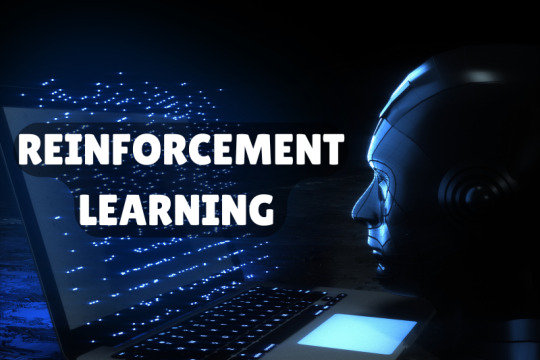
Reinforcement learning (RL) is one of the most exciting areas of artificial intelligence. Unlike supervised learning, where the model is trained on labeled data, RL teaches an agent to make decisions by rewarding it for good actions and punishing it for bad ones. This approach is often used for tasks that require decision-making in dynamic environments, such as robotics, game-playing, and even self-driving cars.
One of the most well-known applications of RL is AlphaGo, where Google’s DeepMind AI defeated a world champion at the complex game of Go. But RL is now making waves in areas beyond gaming, including autonomous vehicles, financial trading, and even energy optimization.
In robotics, RL helps machines learn to perform complex tasks like walking or picking up objects. By continually improving their performance through trial and error, robots become more adaptable and efficient over time.
For businesses, reinforcement learning offers opportunities to optimize everything from marketing strategies to supply chains. It’s about learning the best actions in real-time, which can significantly improve operational efficiency.
At Excelsior Technologies, we help companies harness the power of reinforcement learning to solve complex, dynamic problems, bringing intelligent automation to the forefront of modern business practices.
3 notes
·
View notes
Text
What is artificial intelligence (AI)?

Imagine asking Siri about the weather, receiving a personalized Netflix recommendation, or unlocking your phone with facial recognition. These everyday conveniences are powered by Artificial Intelligence (AI), a transformative technology reshaping our world. This post delves into AI, exploring its definition, history, mechanisms, applications, ethical dilemmas, and future potential.
What is Artificial Intelligence? Definition: AI refers to machines or software designed to mimic human intelligence, performing tasks like learning, problem-solving, and decision-making. Unlike basic automation, AI adapts and improves through experience.
Brief History:
1950: Alan Turing proposes the Turing Test, questioning if machines can think.
1956: The Dartmouth Conference coins the term "Artificial Intelligence," sparking early optimism.
1970s–80s: "AI winters" due to unmet expectations, followed by resurgence in the 2000s with advances in computing and data availability.
21st Century: Breakthroughs in machine learning and neural networks drive AI into mainstream use.
How Does AI Work? AI systems process vast data to identify patterns and make decisions. Key components include:
Machine Learning (ML): A subset where algorithms learn from data.
Supervised Learning: Uses labeled data (e.g., spam detection).
Unsupervised Learning: Finds patterns in unlabeled data (e.g., customer segmentation).
Reinforcement Learning: Learns via trial and error (e.g., AlphaGo).
Neural Networks & Deep Learning: Inspired by the human brain, these layered algorithms excel in tasks like image recognition.
Big Data & GPUs: Massive datasets and powerful processors enable training complex models.
Types of AI
Narrow AI: Specialized in one task (e.g., Alexa, chess engines).
General AI: Hypothetical, human-like adaptability (not yet realized).
Superintelligence: A speculative future AI surpassing human intellect.
Other Classifications:
Reactive Machines: Respond to inputs without memory (e.g., IBM’s Deep Blue).
Limited Memory: Uses past data (e.g., self-driving cars).
Theory of Mind: Understands emotions (in research).
Self-Aware: Conscious AI (purely theoretical).
Applications of AI
Healthcare: Diagnosing diseases via imaging, accelerating drug discovery.
Finance: Detecting fraud, algorithmic trading, and robo-advisors.
Retail: Personalized recommendations, inventory management.
Manufacturing: Predictive maintenance using IoT sensors.
Entertainment: AI-generated music, art, and deepfake technology.
Autonomous Systems: Self-driving cars (Tesla, Waymo), delivery drones.
Ethical Considerations
Bias & Fairness: Biased training data can lead to discriminatory outcomes (e.g., facial recognition errors in darker skin tones).
Privacy: Concerns over data collection by smart devices and surveillance systems.
Job Displacement: Automation risks certain roles but may create new industries.
Accountability: Determining liability for AI errors (e.g., autonomous vehicle accidents).
The Future of AI
Integration: Smarter personal assistants, seamless human-AI collaboration.
Advancements: Improved natural language processing (e.g., ChatGPT), climate change solutions (optimizing energy grids).
Regulation: Growing need for ethical guidelines and governance frameworks.
Conclusion AI holds immense potential to revolutionize industries, enhance efficiency, and solve global challenges. However, balancing innovation with ethical stewardship is crucial. By fostering responsible development, society can harness AI’s benefits while mitigating risks.
2 notes
·
View notes
Text
Best 10 Blockchain Development Companies in India 2025
Blockchain technology is transforming industries by enhancing security, transparency, and efficiency. With India's growing IT ecosystem, several companies specialize in blockchain development services, catering to industries like finance, healthcare, supply chain, and gaming. If you're looking for a trusted blockchain development company in India, here are the top 10 companies in 2025 that are leading the way with cutting-edge blockchain solutions.
1. Comfygen
Comfygen is a leading blockchain development company in India, offering comprehensive blockchain solutions for businesses worldwide. Their expertise includes smart contract development, dApps, DeFi platforms, NFT marketplaces, and enterprise blockchain solutions. With a strong focus on security and scalability, Comfygen delivers top-tier blockchain applications tailored to business needs.
Key Services:
Smart contract development
Blockchain consulting & integration
NFT marketplace development
DeFi solutions & decentralized exchanges (DEX)
2. Infosys
Infosys, a globally recognized IT giant, offers advanced blockchain solutions to enterprises looking to integrate distributed ledger technology (DLT) into their operations. Their blockchain services focus on supply chain, finance, and identity management.
Key Services:
Enterprise blockchain solutions
Smart contracts & decentralized apps
Blockchain security & auditing
3. Wipro
Wipro is known for its extensive research and development in blockchain technology. They help businesses integrate blockchain into their financial systems, healthcare, and logistics for better transparency and efficiency.
Key Services:
Blockchain consulting & strategy
Supply chain blockchain solutions
Smart contract development
4. Tata Consultancy Services (TCS)
TCS is a pioneer in the Indian IT industry and provides robust blockchain solutions, helping enterprises optimize business processes with secure and scalable decentralized applications.
Key Services:
Enterprise blockchain development
Tokenization & digital asset solutions
Decentralized finance (DeFi) applications
5. Hyperlink InfoSystem
Hyperlink InfoSystem is a well-established blockchain development company in India, specializing in building customized blockchain solutions for industries like finance, gaming, and supply chain.
Key Services:
Blockchain-based mobile app development
Smart contract auditing & security
NFT marketplace & DeFi solutions
6. Tech Mahindra
Tech Mahindra provides blockchain-as-a-service (BaaS) solutions, ensuring that businesses leverage blockchain for improved transparency and automation. They focus on finance, telecom, and supply chain industries.
Key Services:
Blockchain implementation & consulting
dApp development & smart contracts
Digital identity management solutions
7. Antier Solutions
Antier Solutions is a specialized blockchain development firm offering DeFi solutions, cryptocurrency exchange development, and metaverse applications. They provide custom blockchain solutions for startups and enterprises.
Key Services:
DeFi platform development
NFT & metaverse development
White-label crypto exchange development
8. HCL Technologies
HCL Technologies offers enterprise blockchain development services, focusing on improving security, efficiency, and automation across multiple sectors.
Key Services:
Blockchain-based digital payments
Hyperledger & Ethereum development
Secure blockchain network architecture
9. SoluLab
SoluLab is a trusted blockchain development company working on Ethereum, Binance Smart Chain, and Solana-based solutions for businesses across industries.
Key Services:
Smart contract & token development
Decentralized application (dApp) development
AI & blockchain integration
10. Mphasis
Mphasis provides custom blockchain solutions to enterprises, ensuring secure transactions and seamless business operations.
Key Services:
Blockchain for banking & financial services
Smart contract development & deployment
Blockchain security & risk management
Conclusion
India is emerging as a global hub for blockchain technology, with companies specializing in secure, scalable, and efficient blockchain development services. Whether you're a startup or an enterprise looking for custom blockchain solutions, these top 10 blockchain development companies in India provide world-class expertise and innovation.
Looking for the best blockchain development partner? Comfygen offers cutting-edge blockchain solutions to help your business thrive in the decentralized era. Contact us today to start your blockchain journey!
2 notes
·
View notes
Text
AI Agent Development: How to Create Intelligent Virtual Assistants for Business Success
In today's digital landscape, businesses are increasingly turning to AI-powered virtual assistants to streamline operations, enhance customer service, and boost productivity. AI agent development is at the forefront of this transformation, enabling companies to create intelligent, responsive, and highly efficient virtual assistants. In this blog, we will explore how to develop AI agents and leverage them for business success.

Understanding AI Agents and Virtual Assistants
AI agents, or intelligent virtual assistants, are software programs that use artificial intelligence, machine learning, and natural language processing (NLP) to interact with users, automate tasks, and make decisions. These agents can be deployed across various platforms, including websites, mobile apps, and messaging applications, to improve customer engagement and operational efficiency.
Key Features of AI Agents
Natural Language Processing (NLP): Enables the assistant to understand and process human language.
Machine Learning (ML): Allows the assistant to improve over time based on user interactions.
Conversational AI: Facilitates human-like interactions.
Task Automation: Handles repetitive tasks like answering FAQs, scheduling appointments, and processing orders.
Integration Capabilities: Connects with CRM, ERP, and other business tools for seamless operations.
Steps to Develop an AI Virtual Assistant
1. Define Business Objectives
Before developing an AI agent, it is crucial to identify the business goals it will serve. Whether it's improving customer support, automating sales inquiries, or handling HR tasks, a well-defined purpose ensures the assistant aligns with organizational needs.
2. Choose the Right AI Technologies
Selecting the right technology stack is essential for building a powerful AI agent. Key technologies include:
NLP frameworks: OpenAI's GPT, Google's Dialogflow, or Rasa.
Machine Learning Platforms: TensorFlow, PyTorch, or Scikit-learn.
Speech Recognition: Amazon Lex, IBM Watson, or Microsoft Azure Speech.
Cloud Services: AWS, Google Cloud, or Microsoft Azure.
3. Design the Conversation Flow
A well-structured conversation flow is crucial for user experience. Define intents (what the user wants) and responses to ensure the AI assistant provides accurate and helpful information. Tools like chatbot builders or decision trees help streamline this process.
4. Train the AI Model
Training an AI assistant involves feeding it with relevant datasets to improve accuracy. This may include:
Supervised Learning: Using labeled datasets for training.
Reinforcement Learning: Allowing the assistant to learn from interactions.
Continuous Learning: Updating models based on user feedback and new data.
5. Test and Optimize
Before deployment, rigorous testing is essential to refine the AI assistant's performance. Conduct:
User Testing: To evaluate usability and responsiveness.
A/B Testing: To compare different versions for effectiveness.
Performance Analysis: To measure speed, accuracy, and reliability.
6. Deploy and Monitor
Once the AI assistant is live, continuous monitoring and optimization are necessary to enhance user experience. Use analytics to track interactions, identify issues, and implement improvements over time.
Benefits of AI Virtual Assistants for Businesses
1. Enhanced Customer Service
AI-powered virtual assistants provide 24/7 support, instantly responding to customer queries and reducing response times.
2. Increased Efficiency
By automating repetitive tasks, businesses can save time and resources, allowing employees to focus on higher-value tasks.
3. Cost Savings
AI assistants reduce the need for large customer support teams, leading to significant cost reductions.
4. Scalability
Unlike human agents, AI assistants can handle multiple conversations simultaneously, making them highly scalable solutions.
5. Data-Driven Insights
AI assistants gather valuable data on customer behavior and preferences, enabling businesses to make informed decisions.
Future Trends in AI Agent Development
1. Hyper-Personalization
AI assistants will leverage deep learning to offer more personalized interactions based on user history and preferences.
2. Voice and Multimodal AI
The integration of voice recognition and visual processing will make AI assistants more interactive and intuitive.
3. Emotional AI
Advancements in AI will enable virtual assistants to detect and respond to human emotions for more empathetic interactions.
4. Autonomous AI Agents
Future AI agents will not only respond to queries but also proactively assist users by predicting their needs and taking independent actions.
Conclusion
AI agent development is transforming the way businesses interact with customers and streamline operations. By leveraging cutting-edge AI technologies, companies can create intelligent virtual assistants that enhance efficiency, reduce costs, and drive business success. As AI continues to evolve, embracing AI-powered assistants will be essential for staying competitive in the digital era.
5 notes
·
View notes
Text
Optimise Your Process with an Automated Label Applicator
Upgrade your packaging system with an automated label applicator that ensures precise label placement. This solution enhances speed and reduces manual handling, making it perfect for businesses looking to streamline operations. Get in touch today for detailed product specifications
0 notes
Text
Pitch N Hire's Guide to Crafting an ATS-Friendly Resume for Better Hiring Outcomes

What is an ATS? An Application Tracking System (ATS), alternatively known as a talent management system, is the software utilized by recruiters and employers for picking up, organizing and sorting out resumes according to particular guidelines. The main aim of an ATS is to simplify the process of hiring by eliminating irrelevant applicants and highlighting those whose qualifications correspond well with the job description. While saving time for HR departments, this also means that candidates must format their CVs properly. 3 Main Tips for an ATS-Friendly Resume:
No Header or Footer: Most ATS can't handle parsing information that goes into either of these two sections. Vital details, such as contact information, name, and title, need to be within the main body of the document. Keeping everything in a simple, easy-to-read format will help the ATS capture all your information correctly.
Keep it Simple: Elements for an ATS-friendly resume are quite minimalistic. Ensure common fonts such as Arial and Times New Roman are in use. Further, shun graphics, tables, or complex formatting in your resume. Traditional resume sections are critical: stick to sections like "Education," "Experience," and "Skills," making sure these are clearly labelled.
Use Keywords: Keywords are a very important feature in an ATS resume. Every content prepared on your resume will be scanned by an ATS to pick out relevant keywords about the description of the jobs. It makes it easy to beat the scanner by the use of relevant keywords that tally with the job posting. Be cautious not to stuff the resume with keywords; they must fit naturally into your content. How can Pitch N Hire help you? Pitch N Hire offers tailored services for job seekers and recruiters. For job seekers, Pitch N Hire offers automation tools that help you create an ATS-friendly resume, ensuring that potential employees wear it noticeably. Their platform also offers a range of job search tools, career counselling and personal career recommendations. For recruiters, Pitch N Hire offers advanced ATS tools that efficiently edit and organize resumes and simplify the hiring process. Their services include candidate management, interview processing and data-driven insights, all geared towards speeding up and improving the recruitment process.
#applicant tracking software#branding#hiring#job#job applications#applicant tracking system#hiring and recruiting#entrepreneur#jobs
5 notes
·
View notes
Text
SOURCE PROTOCOL

SOURCE is building limitless enterprise applications on a secure and sustainable global network. Defi white-labelled services, NFT markets, RWA tokenization, play-to-earn gaming, Internet of Things, data management and more. SOURCE is providing blockchain solutions to the real world and leveraging the power of interoperability.
SOURCE competitive advantages over other blockchain projects
For builders & developers — Source Chain’s extremely high speeds (2500–10000+ tx / per second), low cost / gas fees ($0.01 average per tx), and scalability (developers can deploy apps in multiple coding languages using CosmWasm smart contract framework), set it apart as a blockchain built to handle mass adopted applications and tools. Not to mention, it’s interoperable with the entire Cosmos ecosystem.
For users — Source Protocol’s DeFi suite is Solvent and Sustainable (Automated liquidity mechanisms create a continuously self-funded, solvent and liquid network), Reduces Complexity (we’re making Web 3.0 easy to use with tools like Source Token which automate DeFi market rewards), and we’ve implemented Enhanced Security and Governance systems (like Guardian Nodes), which help us track malicious attacks and proposals to create a safer user environment.
For Enterprises — Source Protocol is one of the first to introduce DeFi-as-a-Service (DaaS) in order for existing online banking and fintech solutions to adopt blockchain technology with ease, and source also provides Enterprise Programs which are complete with a partner network of OTC brokerages, crypto exchanges, and neobanks that create a seamless corporate DeFi experience (fiat onboarding, offboarding, and mutli-sig managed wallets)

Why Source Protocol
Firstly, many protocols are reliant on centralized exchanges for liquidity, limiting their ability to scale independently. This creates a lot of the same issues traditional finance has been plagued with for decades.
Next — slow tx speeds, high costs, limited scalability, and inability to collaborate with other chains, has created severe limitations in Gen 2 blockchain infrastructure.
Lastly, there still exists a level of complexity in blockchain applications that remains a barrier to entry for the average user, and there is not enough focus on building “bridges” for the enterprise to adopt this technology easily and quickly.
In summary, consumers are eager for a blockchain ecosystem that can securely and sustainably support mass adopted applications. That’s why we’ve built Source!
Source Protocol’s ecosystem
Source Protocol’s ecosystem includes a full DeFi Suite, a members rewards program and white-label integration capabilities with existing online Web 2.0 enterprises:
Source Swap — An Interchain DEX & AMM built on Source Chain for permission-less listing of $SOURCE-based tokens, native Cosmos SDK assets, cw-20’s, and wrapped Binance Smart Chain (BEP-20) assets.
Source One Market — A peer to peer, non-custodial DeFi marketplace for borrowing, lending, staking, and more. Built on Binance Smart Chain with bridging to Source Chain & native Cosmos SDK assets.
Source Token $SRCX (BEP-20) — the first automated liquidity acquisition and DeFi market participation token built on Binance Smart Chain.
Source One Token $SRC1 (BEP-20) — a governance and incentivized earnings token that powers Source One Market.
Source USX $USX (BEP-20) — Source One Market stablecoin backed and over collateralized by a hierarchy of blue chip crypto assets and stablecoins.
Source Launch Pad — Empowering projects to seamlessly distribute tokens and raise liquidity. ERC-20 and BEP-20 capable.
Source One Card & Members Rewards Program — users can earn from a robust suite of perks and rewards. In the future, Source One Card will enable users to swipe with their crypto assets online and at retail locations in real time.
DeFi-as-a-Service (DaaS) — Seamless white-label integration of Source One Market, Source Swap, Source Launch Pad, and/or Source One Card with existing online banking and financial applications, allowing businesses to bring their customers DeFi capabilities.
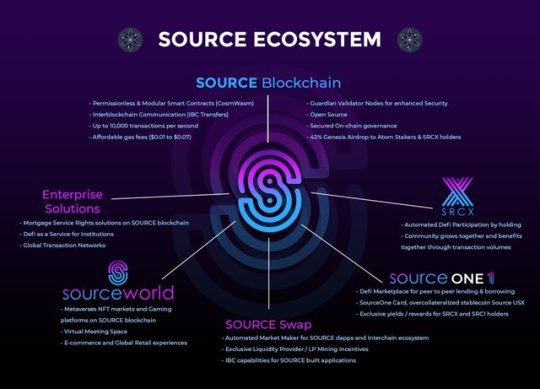
Source Protocol Key Components
Sustainable Growth model built for enterprise involvement and mass application adoption
Guardian Validator Nodes for enhanced network security
Integration with Source Protocol’s Binance Smart Chain Ecosystem and Decentralized Money Market, Source One Market
Source-Drop (Fair community airdrop and asset distribution for ATOM stakers and SRCX holders)
Interoperable smart contracts (IBC)
High speed transaction finality
Affordable gas fees (average of $0.01 per transaction)
Highly scalable infrastructure
Open-source
Permission-less Modular Wasm + (EVM)
Secured on-chain governance
Ease of use for developers
conclusion
SOURCE is a comprehensive blockchain technology suite for individuals, enterprises and developers to easily use, integrate and build web3.0 applications. It is a broad-spectrum technology ecosystem that transforms centralized web tools and financial instruments into decentralized ones. Powering the future of web3,
Next — slow tx speeds, high costs, limited scalability, and inability to collaborate with other chains, has created severe limitations in Gen 2 blockchain infrastructure.
Lastly, there still exists a level of complexity in blockchain applications that remains a barrier to entry for the average user, and there is not enough focus on building “bridges” for the enterprise to adopt this technology easily and quickly.
In summary, consumers are eager for a blockchain ecosystem that can securely and sustainably support mass adopted applications. That’s why we’ve built Source!
For More Information about Source Protocol
Website: https://www.sourceprotocol.io
Documents: https://docs.sourceprotocol.io
Twitter: https://www.twitter.com/sourceprotocol_
Instagram: https://www.instagram.com/sourceprotocol
Telegram: https://t.me/sourceprotocol
Discord: https://discord.gg/zj8xxUCeZQ
Author
Forum Username: Java22
Forum Profile Link: https://bitcointalk.org/index.php?action=profile;u=3443255
SOURCE Wallet Address: source1svnzfy5fafuskeaxmf2sgvgcn6k3sggmssl8d7
2 notes
·
View notes
Text
Getting Machine Learning Accessible to Everyone: Breaking the Complexity Barrier
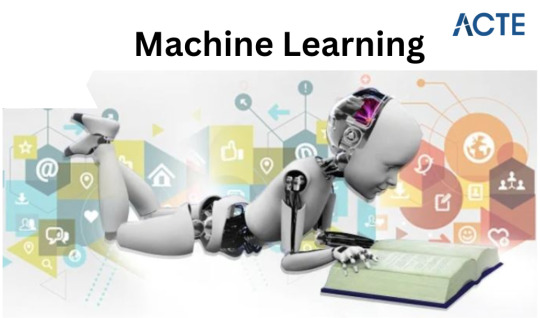
Machine learning has become an essential part of our daily lives, influencing how we interact with technology and impacting various industries. But, what exactly is machine learning? In simple terms, it's a subset of artificial intelligence (AI) that focuses on teaching computers to learn from data and make decisions without explicit programming. Now, let's delve deeper into this fascinating realm, exploring its core components, advantages, and real-world applications.
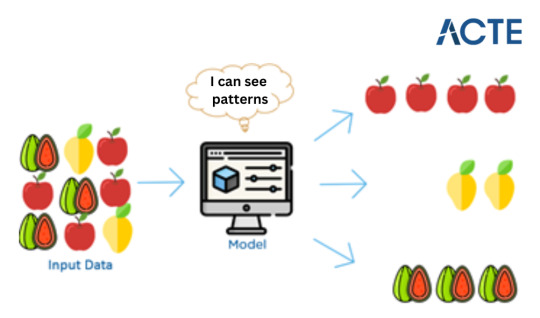
Imagine teaching a computer to differentiate between fruits like apples and oranges. Instead of handing it a list of rules, you provide it with numerous pictures of these fruits. The computer then seeks patterns in these images - perhaps noticing that apples are round and come in red or green hues, while oranges are round and orange in colour. After encountering many examples, the computer grasps the ability to distinguish between apples and oranges on its own. So, when shown a new fruit picture, it can decide whether it's an apple or an orange based on its learning. This is the essence of machine learning: computers learn from data and apply that learning to make decisions.
Key Concepts in Machine Learning
Algorithms: At the heart of machine learning are algorithms, mathematical models crafted to process data and provide insights or predictions. These algorithms fall into categories like supervised learning, unsupervised learning, and reinforcement learning, each serving distinct purposes.
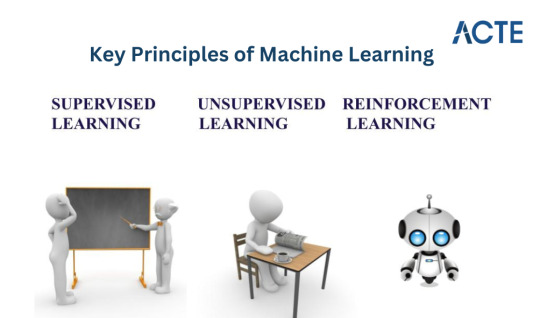
Supervised Learning: This type of algorithm learns from labelled data, where inputs are matched with corresponding outputs. It learns the mapping between inputs and desired outputs, enabling accurate predictions on unseen data.
Unsupervised Learning: In contrast, unsupervised learning involves unlabelled data. This algorithm uncovers hidden patterns or relationships within the data, often revealing insights that weren't initially apparent.
Reinforcement Learning: This algorithm focuses on training agents to make sequential decisions by receiving rewards or penalties from the environment. It excels in complex scenarios such as autonomous driving or gaming.
Training and Testing Data: Training a machine learning model requires a substantial amount of data, divided into training and testing sets. The training data teaches the model patterns, while the testing data evaluates its performance and accuracy.
Feature Extraction and Engineering: Machine learning relies on features, specific attributes of data, to make predictions. Feature extraction involves selecting relevant features, while feature engineering creates new features to enhance model performance.
Benefits of Machine Learning
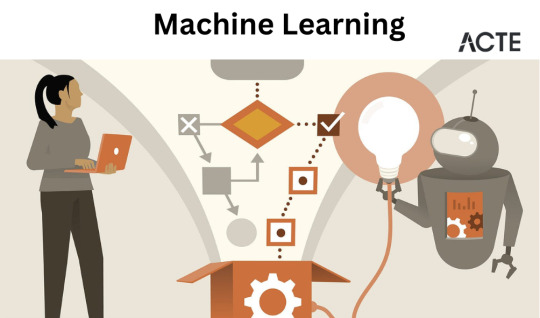
Machine learning brings numerous benefits that contribute to its widespread adoption:
Automation and Efficiency: By automating repetitive tasks and decision-making processes, machine learning boosts efficiency, allowing resources to be allocated strategically.
Accurate Predictions and Insights: Machine learning models analyse vast data sets to uncover patterns and make predictions, empowering businesses with informed decision-making.
Adaptability and Scalability: Machine learning models improve with more data, providing better results over time. They can scale to handle large datasets and complex problems.
Personalization and Customization: Machine learning enables personalized user experiences by analysing preferences and behaviour, fostering customer satisfaction.
Real-World Applications of Machine Learning
Machine learning is transforming various industries, driving innovation:
Healthcare: Machine learning aids in medical image analysis, disease diagnosis, drug discovery, and personalized medicine. It enhances patient outcomes and streamlines healthcare processes.
Finance: In finance, machine learning enhances fraud detection, credit scoring, and risk analysis. It supports data-driven decisions and optimization.
Retail and E-commerce: Machine learning powers recommendations, demand forecasting, and customer behaviour analysis, optimizing sales and enhancing customer experiences.
Transportation: Machine learning contributes to traffic prediction, autonomous vehicles, and supply chain optimization, improving efficiency and safety.
Incorporating machine learning into industries has transformed them. If you're interested in integrating machine learning into your business or learning more, consider expert guidance or specialized training, like that offered by ACTE institute. As technology advances, machine learning will continue shaping our future in unimaginable ways. Get ready to embrace its potential and transformative capabilities.
#machine learning ai#learn machine learning#machine learning#machine learning development company#technology#machine learning services
8 notes
·
View notes
Text
Best data extraction services in USA
In today's fiercely competitive business landscape, the strategic selection of a web data extraction services provider becomes crucial. Outsource Bigdata stands out by offering access to high-quality data through a meticulously crafted automated, AI-augmented process designed to extract valuable insights from websites. Our team ensures data precision and reliability, facilitating decision-making processes.
For more details, visit: https://outsourcebigdata.com/data-automation/web-scraping-services/web-data-extraction-services/.
About AIMLEAP
Outsource Bigdata is a division of Aimleap. AIMLEAP is an ISO 9001:2015 and ISO/IEC 27001:2013 certified global technology consulting and service provider offering AI-augmented Data Solutions, Data Engineering, Automation, IT Services, and Digital Marketing Services. AIMLEAP has been recognized as a ‘Great Place to Work®’.
With a special focus on AI and automation, we built quite a few AI & ML solutions, AI-driven web scraping solutions, AI-data Labeling, AI-Data-Hub, and Self-serving BI solutions. We started in 2012 and successfully delivered IT & digital transformation projects, automation-driven data solutions, on-demand data, and digital marketing for more than 750 fast-growing companies in the USA, Europe, New Zealand, Australia, Canada; and more.
-An ISO 9001:2015 and ISO/IEC 27001:2013 certified -Served 750+ customers -11+ Years of industry experience -98% client retention -Great Place to Work® certified -Global delivery centers in the USA, Canada, India & Australia
Our Data Solutions
APISCRAPY: AI driven web scraping & workflow automation platform APISCRAPY is an AI driven web scraping and automation platform that converts any web data into ready-to-use data. The platform is capable to extract data from websites, process data, automate workflows, classify data and integrate ready to consume data into database or deliver data in any desired format.
AI-Labeler: AI augmented annotation & labeling solution AI-Labeler is an AI augmented data annotation platform that combines the power of artificial intelligence with in-person involvement to label, annotate and classify data, and allowing faster development of robust and accurate models.
AI-Data-Hub: On-demand data for building AI products & services On-demand AI data hub for curated data, pre-annotated data, pre-classified data, and allowing enterprises to obtain easily and efficiently, and exploit high-quality data for training and developing AI models.
PRICESCRAPY: AI enabled real-time pricing solution An AI and automation driven price solution that provides real time price monitoring, pricing analytics, and dynamic pricing for companies across the world.
APIKART: AI driven data API solution hub APIKART is a data API hub that allows businesses and developers to access and integrate large volume of data from various sources through APIs. It is a data solution hub for accessing data through APIs, allowing companies to leverage data, and integrate APIs into their systems and applications.
Locations: USA: 1-30235 14656 Canada: +1 4378 370 063 India: +91 810 527 1615 Australia: +61 402 576 615 Email: [email protected]
2 notes
·
View notes
Text
Food ordering & delivery dilemma? A simple software solution can do all the hard work for you

Since ecommerce has started penetrating into the lives of people, the diversity of items being ordered and delivered online has been increasing. Online Food Delivery: A Growing Trend
Among the various products being delivered online is the food products. The changing lifestyles of people and the increased utilization of technology are the major factors driving consumers towards online food orders.
Nowadays, people find it difficult to cook food due to multiple reasons which include working at a workplace or preparing for a party in a short period of time. Getting the items delivered to their doorsteps has become the most preferred option among the people. Here technology is providing unparalleled convenience to consumers by letting them order food in a few clicks on their smartphones or laptops and get it delivered.
Online food ordering and delivery has turned out to be a boon not only for consumers but also for restaurants and small food outlets. The increasing number of food businesses going online indicates the same.
Revenue in the Online Food Delivery market is projected to reach US$1tn in 2023 and is expected to show an annual growth rate (CAGR 2023-2027) of 12.78%, resulting in a projected market volume of US$2tn by 2027.
Having understood the importance of running online, food businesses are looking for the food delivery software that suits them best and gives them an edge in the fiercely growing market.
Here in this short blog, I will help you get rid of the dilemma of choosing the food delivery solution for your business. Food is a perishable item that loses its taste and quality if not delivered on time. Thus, it is not only necessary for businesses to consider smooth ordering but also quick delivery to determine their future. Critical Factors for Success: Key Features of Effective Food Delivery Software
Efficient Mobile Applications: In an age where the role of technology is paramount, running an online food business without utilizing mobile apps will take your business nowhere. Consumers could easily download the app on their smartphones and place orders for their favourite dishes in a few clicks. Similarly, for restaurants and delivery agents, their respective app ensures that they manage their functions smoothly. The apps for the restaurants allow the owners to upload the details of the products in bulk on a touch apart from accepting orders and marking the availability of food items. The driver app, used by delivery agents, displays the optimized route for safe and quick delivery.
Bringing Automation for Faster Delivery: Today, 10-minute delivery has become a trend. The time taken to deliver the food items determines the success of the business. This urgency has led to the emergence of hyperlocal ecommerce that depends upon small geographical areas and robust software to deliver the customers in a minimum time. Failing to achieve quick delivery will drift your customers to your rivals. Thus, to meet the customers’ expectations, the online food delivery software must be empowered with automation in the process to eliminate the time taken in doing manual tasks. For example, automatically assigning the delivery task to the most suitable agent is one of the characteristics of an efficient solution.
White-label Solution: Nowadays, the white-label food delivery solution has become the most preferred choice among businesses. An efficient solution must facilitate the branding of the online food delivery company instead of the software company. It ensures that the consumers get to see the name of the food business in their entire buying process.
Easy to Introduce New Features: The changing requirements in the market keep businesses on their toes. Various new features need to be added to the software for online food businesses to align with the market demands. The cloud-based food delivery software is best in this case as the onus of introducing new features lies on the software company rather than the delivery business. This ensures that the business owner delegates all the hard work to the software company and focuses himself towards business growth.
Multiple Online Payment Options: Transaction forms the most important part of any business. Different customers use different modes of payment methods to complete their purchases. Keeping note of this, the food delivery software is armed with several payment options like payment gateways, card payment, and cash on delivery, among others. Depending upon the restaurant’s requirement, they may choose the payment options to be available for the consumers to pay for their orders.
Promotional Tools: Retaining loyal customers and increasing the number of buyers is at the core of any business. For this, businesses put in lots of effort by utilizing various marketing strategies. Today, there is fierce competition in the online food delivery business and it is paramount to expand the customer base. For this to be achieved, modern food ordering software must come up with various in-built marketing tools like referral programs, loyalty rewards, and facilities to create discounts and offers. These promotional tools ensure the increase of cart value and maximise the profit margin.
Location-based Service: In the case of an online food business, quick delivery plays an essential role. A delayed delivery results in food losing its taste and thereby, leads to the shrinkage of customer base. To ensure timely delivery from the restaurant to the customer’s doorsteps, the food delivery software must display the restaurants that are closest to the customers first. Ordering from them will help in the delivery of the food item in a minimum time. Also, the restaurants must be able to mark the area of delivery such that the consumers can’t get the items delivered in that area. This feature helps in the odd times like during rain.
Free from Technicalities: Technicalities of food delivery software should not become a hindrance to the growth of a business. The software should be designed in a way that anyone, with or without technical expertise, can use it easily. This will act as a driving force for all the stakeholders including restaurants and consumers to make the best use of the software.
Final Words
To make a mark in the food delivery industry, just the intent of the business owner is not enough. It is the futuristic food delivery software that will play its role on an equal footing.
#food delivery software#online food delivery software#food delivery solution#food ordering software#online food ordering software
2 notes
·
View notes
Text
What are the latest warehouse automation technologies?
Gone are the days of manual labour and static, inefficient operations. Today, we stand at the forefront of a revolution driven by the latest warehouse automation technologies. These innovations reshape how businesses handle inventory, fulfil orders, and optimize supply chains.
From autonomous robots and artificial intelligence to the Internet of Things (IoT) and advanced data analytics, we'll explore how these technologies enhance efficiency, reduce costs, and ensure seamless operations in modern warehouses.
1-Robotic Process Automation (RPA): RPA involves using software robots to automate repetitive tasks like data entry, order processing, and inventory tracking. The robots interact with various systems and applications to streamline workflows.
2-Autonomous Mobile Robots (AMRs): Robotic vehicles called AMRs navigate and operate in warehouses without fixed infrastructure, such as conveyor belts or tracks. They perform tasks like picking, packing, and transporting goods.
3-Automated Guided Vehicles (AGVs): AGVs are similar to AMRs but typically follow fixed paths or routes guided by physical markers or magnetic tape. They are commonly used for material transport in warehouses and distribution centres.
4-Goods-to-Person Systems: This approach involves bringing the items to the workers rather than having workers travel throughout the warehouse to pick items. Automated systems retrieve and deliver goods to a workstation, reducing walking time and improving efficiency.
5-Automated Storage and Retrieval Systems (AS/RS): AS/RS systems use robotics to store and retrieve items from racks or shelves automatically. These systems can significantly increase storage density and optimize space utilization.
6-Collaborative Robots (Cobots): Cobots are designed to work alongside human workers. They can assist with tasks like picking, packing and sorting, enhancing efficiency and safety.
7-Warehouse Management Systems (WMS): While not a physical automation technology, modern WMS software uses advanced algorithms and AI to optimize inventory management, order fulfilment, and warehouse processes.
8-Vision Systems and Machine Learning: Computer vision technology combined with machine learning can be utilized for tasks such as object recognition, inventory movement tracking, and quality control.
9-IoT and Sensor Networks: Internet of Things (IoT) devices and sensors collect real-time data on inventory levels, environmental conditions, equipment health, and more, enabling better decision-making and predictive maintenance.
10-Voice and Wearable Technologies: Wearable devices and voice-guided picking systems can provide workers with real-time information and instructions, improving accuracy and efficiency.11-Automated Packaging Solutions: These systems automate the packaging process by selecting the appropriate box size, sealing packages, and applying labels, reducing manual labour and ensuring consistent packaging quality.
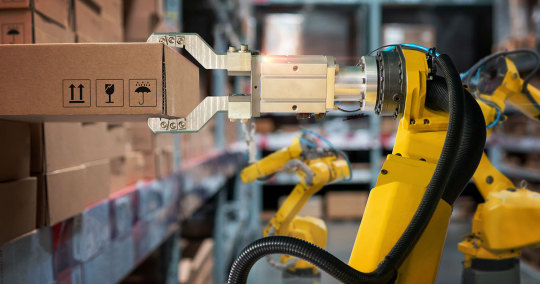
1 note
·
View note